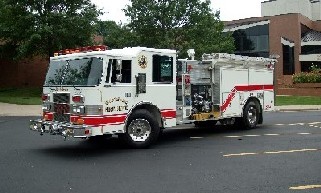 2513 is a 1993 Pierce attack pumper. It has a 1500 GPM pump with a 1000 gallon tank. It has a 5-man cab with 1000 feet of 4" LDH hose. It is equipped with pre-connect attack lines, piped deck gun, portable thermal imaging unit, along with firefighting tools and appliances. It was refurbished in 2007. 2513 is a 1993 Pierce attack pumper. It has a 1500 GPM pump with a 1000 gallon tank. It has a 5-man cab with 1000 feet of 4" LDH hose. It is equipped with pre-connect attack lines, piped deck gun, portable thermal imaging unit, along with firefighting tools and appliances. It was refurbished in 2007. |
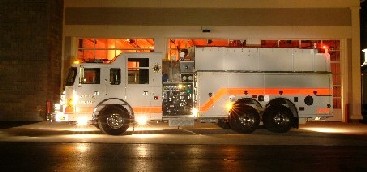 2518 is a 2000 Pierce pumper/tanker. It has a 1500 GPM pump with a 3000 gallon tank. It has a 5-man cab with 1000 feet of 4" LDH hose. It has a side dump on the driver and passenger side which can be operated from the driver’s seat and a rear 10" Nelson jet dump. It has a 6" pre-connected drafting line mounted on the front bumper. It is equipped with pre-connect attack lines, piped deck gun, portable dump tank, along with firefighting tools and appliances. 2518 is a 2000 Pierce pumper/tanker. It has a 1500 GPM pump with a 3000 gallon tank. It has a 5-man cab with 1000 feet of 4" LDH hose. It has a side dump on the driver and passenger side which can be operated from the driver’s seat and a rear 10" Nelson jet dump. It has a 6" pre-connected drafting line mounted on the front bumper. It is equipped with pre-connect attack lines, piped deck gun, portable dump tank, along with firefighting tools and appliances. |
 2519 is a 2011 75' Pierce Aerial Ladder. It has a 1500 GPM pump with a 500 gallon tank. It is equipped with an assortment of ground ladders, set of rescue tools "Jaws of Life", stabilization devices (air bags/jacks/etc.), along with firefighting tools and appliances. 2519 is a 2011 75' Pierce Aerial Ladder. It has a 1500 GPM pump with a 500 gallon tank. It is equipped with an assortment of ground ladders, set of rescue tools "Jaws of Life", stabilization devices (air bags/jacks/etc.), along with firefighting tools and appliances. |
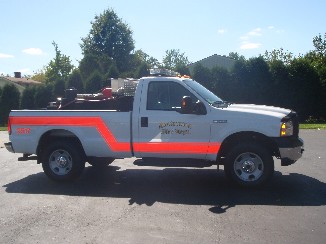 2517 is a 2006 Ford F-350 wildland firefighting unit. It has a Honda/Darley pump with a 214 gallon water tank. It is equipped with 2 pre-connect 1" forestry attack lines, a Warn winch, and an assortment of wildland firefighting tools and appliances. This unit is also used to transport the Portage County Hazardous Materials Spills Trailer which is housed and maintained at the Rootstown Fire station. 2517 is a 2006 Ford F-350 wildland firefighting unit. It has a Honda/Darley pump with a 214 gallon water tank. It is equipped with 2 pre-connect 1" forestry attack lines, a Warn winch, and an assortment of wildland firefighting tools and appliances. This unit is also used to transport the Portage County Hazardous Materials Spills Trailer which is housed and maintained at the Rootstown Fire station. |
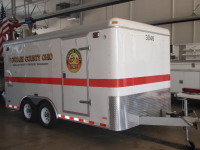 3046 is the Portage County Department of Homeland security Hazardous Materials Spill response trailer. It is stored and maintained at the Rootstown fire station. Rootstown Fire Department Hazardous Materials Team members respond the unit with 2517 directly to the scene or staging area of an incident. The unit contains numerous materials and tools used to contain spills and prevent further harm from the spill. 3046 is the Portage County Department of Homeland security Hazardous Materials Spill response trailer. It is stored and maintained at the Rootstown fire station. Rootstown Fire Department Hazardous Materials Team members respond the unit with 2517 directly to the scene or staging area of an incident. The unit contains numerous materials and tools used to contain spills and prevent further harm from the spill.
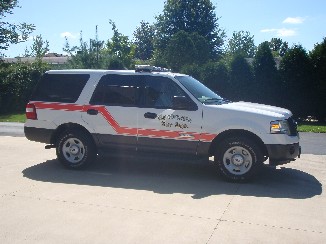 2526 is a 2007 Ford Expedition multi-purpose vehicle. This vehicle is utilized to transport additional personnel to the scene of medical and fire calls. Certain medical calls require an additional staff member on scene but not during the transport of the patient to the end care treatment facility. This allows a staffed member to return to station to respond to the next call. This unit is also used for day to day activities of the fire department such as inspections, meetings/appointments, training classes, township information updating (Map Books), fire investigations, or any other department activity that would not require the 1st response of an EMS unit or Fire engine. 2526 is a 2007 Ford Expedition multi-purpose vehicle. This vehicle is utilized to transport additional personnel to the scene of medical and fire calls. Certain medical calls require an additional staff member on scene but not during the transport of the patient to the end care treatment facility. This allows a staffed member to return to station to respond to the next call. This unit is also used for day to day activities of the fire department such as inspections, meetings/appointments, training classes, township information updating (Map Books), fire investigations, or any other department activity that would not require the 1st response of an EMS unit or Fire engine.
| |